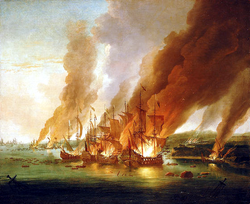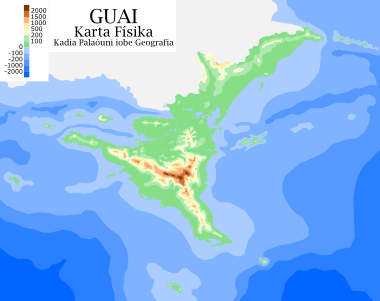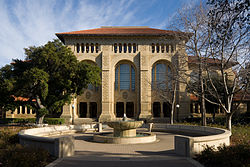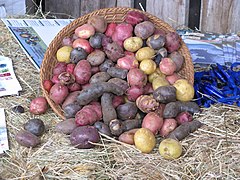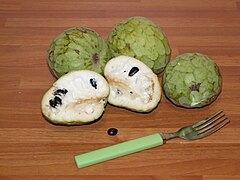Guai
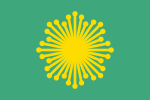
|
Guai Capital: Pirindi
Population: 5,871,750 (2015) Anthem: Ios Guai |
Loading map... |
Guai (pronounced /gwaj/), is a country located on the northwestern coast of Antarephia. Guai is bordered to the North by Oxhano, AN136b, Kopersia and Alejeverdi and The Kōpere Bay; by The Koropiko Bay to the East; and by the Hesperic Ocean to the South and West. Its capital is Pirindi and the largest city is Vai. It is a small country of 29,056 km2 (11,219 sq mi) and has a population of about 6 million people.
Etymology
Guai (oudated Ingerish spelling Gwigh) derives from pre-Taukan root Guo (/gwo/), possibly meaning "fertile plain", and -ai suffix denoting a region or a country, hence, "Land/Region of the fertile plain". Historically speaking, Guai was only the central plain located mostly astride Urán and Astel Cantons. Guai has no official name. Consequently, it is referred just as Guai for all official purposes.
History
| History of Guai | |
|---|---|
| Prehistory | 15000 BC - 1500 BC |
| • Kailan Stone Age | 4000 BC - 3000 BC |
| • Kaitan Cultures | 3000 BC - 1500 BC |
| Classical to Early Modern Taukan | 2000 BC - 1649 AD |
| • Arrival of Taukan Tribes | 2000 BC - 500 BC |
| • Silver Age | 500 BCE - 200 AD |
| • First Golden Age | 200 - 1502 |
| • Ulethan colonies & Sabishiian Kingdom | 1502 - 1652 |
| Early Modern to Modern Age | 1652 onwards |
| • Old Republic & Second Golden Age | 1652 - 1791 |
| • First Constitution | 1791 |
| • Sabishiian War | 1831 - 1833 |
| • New Republic | 1848 |
Prehistory
What is now Guai has been inhabited since at least 15000 BC. The oldest archaeological remains are those found in Egi Stof Cave, near Uari. By 3000 BC elements of pre-Taukan culture, collectively known as Kaitese Peoples, developed in the lower Kaita River Plain and along the northern coast of present-day Uloa. Kaitese seems to have been farmers, mastering Bronze and Iron metallurgy, living in villages surrounded by wooden walls. They are supposed to have been culturally related to the more primitive tribes that inhabited the southern half of the Guaiian Peninsula, but due to the poor quality of the Kaitese artefacts, little is known about them before the arrival of the Taukans.
Classical to Early Modern Taukan
Arrival of Taukan Tribes
Taukan tribes that had established along the northeastern coast of the Korpiko, started to move westward, reaching Guai between 2000 BC and 1000 BC. Some of these tribes' names are known through the written archives they kept of some of their activities (namely, trades and political decisions). Their Abugida writing system was in use until the late 17th when Romantian alphabet superseded it completely. By 500 BC, Kaitese people had completely fused with the Taukan tribes, leaving some oronyms and hydronyms still existent and, agricultural techniques priorly unknown to the Taukans.
Silver Age
The Taukans organised themselves in sets of city-states, generally ruled by a council of the elders comprising male representatives of patrician families. These city-states are usually divided into those based agriculture and/or mining and those dedicated to trade by sea or land routes. This period, lasting from 500 BC to 200 AD, is known as the Silver Age.
First Golden Age
The Golden Age or First Golden Age covers the period lasting from 200 AD to the early-16th century. Guaiian city-states underwent long peaceful and prosperous periods interrupted by short wars between cities. By the mid-12th century, Pirindi had expanded its power over the Central Guaiian Plain (then known as Guai), covering today's Poka, Urán, Poro Vai and part of Astel and Uloa Cantons. Thanks to its central position, the Republic of Pirindi controlled trade between North and South of the Peninsula but failed to submit Eastern Guai to its rule, leaving out trade across the Korpiko to eastern thalassocraties.
Ulethan colonies & Sabishiian kingdom
The Castellanese, followed a few decades later by the Ingerish, landed in 1502 around Vai. Due to internal conflicts within the Republic of Pirindi and the bombing of Vai by the Castellanese fleet, a piece of land was ceded to the Castellanese in 1505, on which they were allowed, by the Treaty of Vai Harbour, to build a town with a harbour and a fortress with a limited garrison and, be exempted of any tax when trading with the Republic of Pirindi. Santa María de la Esperanza (today Esperáns) was founded in 1506, a few kilometres west of Vai. In 1584, the Ingerish obtained Saint Georges (now Sandjórj) with similar conditions and almost the same location. These first contacts with Ulethans impacted the Guaiian society profoundly; bringing new food, techniques, words, religious and philosophical concepts. Due to competition between Ingrea and Castellan, the Castellanese withdrew in the early 1600s and Santa María de la Esperanza was considered abandoned in 1609, 103 years after its foundation. Saint Georges and its Guaiian suburbs Igri (archaic term for Ingerish) flourished for next half century, although the terms of the original unequal treaty were revised in 1602.
Eastern Guai was not spared some form of colonisation. In the late-16th century, Sabishiian incursions from across the Koropiko had become more frequent and penetrated further into today's Matal Canton (itself a Sabishiian name), triggering the collapse of local city-states. 1598 is usually estimated year of the foundation of Rakaling, the capital of the new Sabishiian Kingdom of Matal. Through various raids over the next decades, the Sabishiian Shetong Dynasty (spelt Cetong in Guaiian) extended its direct control along the coast, from the Rakaling Bay up to Bimars. During the 17th century, this new power diminished considerably the clout of those eastern thalassocraties that had managed to remain independent.
Early Modern to Modern Age
Old Republic & Second Golden Age
In 1632, the Ingerish ransacked Havár, a small town in northern Uloa indebted to the Ingerish colonists. Havár was vassal to the Republic of Keroli and serving as one of its seaports. The powerful Republic of Keroli reacted by building a strong fortress next to Havár and modernising the walls surrounding its eastern seaport of Píap. Simultaneously, it engaged in secret discussions with the Pirindi Council of the Elders,the governing body of the Republic. The terms of the secret agreement consisted in two main parts: one military, one economic. Keroli, Pirindi, their vassal republics and Common Lands (farm lands, unrepresented in governing bodies) were to levy a unified army and navy for their common defence. In parallel, a custom union was to be established to boost trade between the city-states. The 250-day War started in September 1648 and formally ended by the Treaty of Pirindi in June 1649. The war opposing the Ingerish and the Guaiians consisted in a succession of unrelated battles, culminating with the storming of Fort Saint-Georges. While extra-judicial public executions of Ingerish colonists did occur, such as the hanging of rear admiral James Carminowe in the aftermath of the rendition, the terms of the treaty allowed the Ingerish population to stay in Saint Georges, provided they vowed allegiance to the new Union. Due to the lack available Ingerish ship in the immediate years after the rendition, about 40% of 5,300 inhabitants of Saint Georges relocated in Vai where they formed a dynamic mercantile community. By the late 17th century, half of the remaining Ingerish inhabitants of Saint Georges had repatriated or relocated in other Ingerish colonies.
1652, with the signing of Oath on the Oldrín Bridge (Guaiian: Taük obe Pint Oldrín) cementing the Union, is usually considered the start of the Old Republic and of the Second Golden Age. This period was characterised by the enrichment of cities such as Pirindi, Vai or Keroli through newly boosted trades of all sorts, the development of others such as Bimars, home of the new navy, and Kūra, home of a new common national university. The Oath abolished the difference between Common Lands and Republics and, established a common Council of the Elders housed in Pirindi, functioning as a parliament elected by the local Councils of the Elders, themselves elected by local bourgeois men and some land owners. The Council of the Elders on its turn appointed a Council of State, in charge of common issues: defence, external trade, diplomacy and currency matters.
First Constitution
The 1791 Constitution replaced the national Council of the Elders by a National Council, elected by all men over 25 and paying at least a 30-Gold-Lian tax a year. Republics and Common Lands were superseded by new 12 Cantons. This first constitution induced the shift to a more centralised republic and a more homogenous nation, consisting of most of today's Guai except the coastal area still held by the Kingdom of Matal, from the outskirts of Peran, in the Rakaling Bay, to River Elesin, north of Gilin.
Sabishiian War
In the context of the fading prosperity of the Kingdom of Matal, piracy developed along the eastern coast from the early 1800s on. In January 1831, Bimars, the then home of the Guaiian Navy and main sea port trading on the Koropiko was burnt to the ground by the Sabishiian pirates who managed to escape. The event started the Sabishiian War (Guaiian: Korc Sabeci) which constituted the first test for the common army. The war raged southward, mainly in eastern Matal. The Old Republic having few naval ships left after the Raid of Bimars, Rakaling had to be taken by land in November 1832 while skirmishes lasted in the Hinterland until the next April. This put an end to the 235-year-old Kingdom of Matal. No treaty or armistice was ever negotiated or signed, and Sabishiian Matal remained under military rule until the foundation of the New Republic in 1848, fifteen years later. Bimars being in ruins and Rakaling Bay being better-suited, the main naval base was transferred to the latter.
New Republic
After a decade of heated discussions, a new constitution came into force on 12 February 1848, transforming Guai into a modern democracy. The new National Council was to be elected by tax-paying men over 21 and unmarried female landowners. A few years later, in 1862, universal male suffrage was enacted by a first constitutional amendment.
The new parliamentary regime has usually been deemed rather industrious in its first decades when it comes to its legislative work. Centuries-old customs and laws were reviewed, rewritten and codified while new ones were voted to fit an industrialising nation and its every-changing society. Healthcare and pension provision for miners and metallurgy workers were voted in the 1870 and capital punishment in times of peace was abolished in 1908. In 1912 the Constitution was revised to extend universal suffrage to women over 21 and again in 1926 to extend the National Council's term form four to five years. The same year, the National Council voted a new Health Law, grouping several existing healthcare provisions and extending some of them, laying the first bricks of Guai's universal healthcare system. While rather progressive at the turn of the century, Guai politics witnessed a rise of conservative and nationalist parties from the mid-1920s up until the late 1930s.
Though mostly neutral, Guai was economically affected by the tensions leading to the Great War and the War itself. During the 1930s, the Council of State financed the modernisation of the coastal fortifications, the reconstruction of an up-to-date navy and the creation of an air force. In those trouble times, some public initiatives took place such as the foundation of Guai Airways in 1934, of the KoPaSa (the national rail company) in 1941 or Elek Guai (the state power generation company) in 1952. During the Great War, few combats occurred in Guai's vicinity. Among those, Cape Goh Battle in 1942 is usually considered the main one.
Recent history
Though the Great War stimulated some sectors of the Guaiian economy, its end provided a new and larger boost to more parts. From the 1950s to the 1980s, KoPaSa operated a programme of modernisation and rationalisation of its tracks and fleet: Non electrified main lines were electrified in priority while secondary loss-making lines were closed or shortened. In the 1970s Elek Guai started to build and operate the Pórinkon nuclear power plant, extending it in the next decades.
The second half of the 20th century witnessed the secularisation of the Guaiian society. Ohoism, the Guaiian version of amalgamated religio-philosophical Taukan traditions continued to loose ground: the few remaining legal restrictions applied to women were repelled, step-by-step, essentially in the 1960s and early 1970s, while a Registered Partnership Law applying to both heterosexual and homosexual couples was voted in 1988. As Ohoism rarely concerns sexuality, same-sex sexual activity has never been criminalised in Guai or its predecessor states. Same-sex couples have been legally able to marry and adopt since 1998.
The 21st century...
Geography
 | |
|---|---|
| Geography of Guai | |
| Continent | Antarephia |
| Area | |
| • Total | 29,056 km2 11,219 sq mi |
| • Water (%) | 2% |
| Population density | 205 km2 527 sq mi |
| Time zone | WUT +0:30 |
- Lanscape of Guai
Flora & Fauna
- Animals of Guai
- Plants of Guai
Politics
| Government of Guai | |
|---|---|
| Unitary Parliamentary Directorial Republic | |
| Capital | Pirindi |
| Head of state | |
| • Council of State | Fiordja Pemel (President) Hag Uarai (Vice-President) |
| Legislature | National Council |
| Judiciary | High Court of Justice |
Major political parties | |
Tè Ald Moixe Tè Ald Áulera Tè Ald Palaóuni Tè Ald Bandori Tā Uūn Guai í Dja Athrid Guai Tè Koalició Radikál | |
| AN | |
Politics in Guai operates under a framework laid out in the Constitution of Guai. First written in 1848, it made official the system which had been Guai's for over 350 years: a unitary directorial republic. The Constitution was amended many times such as in 1862 to enact universal male suffrage, in 1912 to extend this right to women or 1926 when The National Council's term was changed from four to five years.
There are three main governing bodies on the national level: the unicameral National Council (legislative), the Council of State (executive) and the High Court of Guai (judicial).
Parliament
The Rūn Palaóuni (Guaiian Tè Rūn Palaóuni, pronounced /tə ɾu:n pala’ɔwni/ lit. The People's Council), also known as The National Council in Ingerish, is the unicameral national parliament (legislature) of Guai.
The 179 members serve five-year terms, with elections held every five years, or earlier in the relatively rare case that the National Council dissolves itself. All candidates must be at least eighteen year old, there is no term limit. The elections use the mixed-term mixed-member proportional representation, half of the Members of the National Council are elected directly in the 90 constituencies of Guai, the other half are elected from the parties national lists in such a way as to achieve proportional representation for the total National Council, although a party has to win one electoral seat or 5 percent of the total party vote before it is eligible for these seats.
The National Council holds its sessions in the Council House (Guaiian: Tè Tic Rūn, pronounced /tə tiʃ ɾu:n/), located on the top of Kerma Hill in Pirindi. The Council House was built from 1912 to 1920 in a early Art Déco architecture style. Topped by a 90-metre bell tower, the building is the tallest Pirindi. Until 1921, the Council met in the old town in a former patrician townhouse adapted in the early 19th Century to fit its new role. It is now a museum.
Government
The Rūn Mati (Guaiian Tè Rūn Mati, pronounced /tə ɾu:n 'mati/ lit. The State Council), also known as The Council of State in Ingerish, is the fifteen-member executive council which constitutes the national government of Guai and serves as the collective executive head of government and state of Guai.
It is appointed by The National Council for 5 years, after every new general elections. Legally speaking, the National Council can vote a motion of no confidence in one Councillor or the Council of State collectively. While the entire council is responsible for leading the National administration of Guai, each Councillor heads one of the fifteen national executive departments. The central administration is housed in two twin buildings located on Kerma Hill: The East and West National Administration Buildings.
Local government
Guai is a centralised republic. The institutional and territorial organization is chiefly governed by Territorial Reform Act of 1961. This law provides a two-level system with rov or cantons, and poro or districts (lit. circle). These entities have existed since the late 18th Century with different rights and objectives. Before 1961, Districts were further subdivided into municipalities or inda that ceased to exist as political subdivisions on 1 January 1965. Yet, municipalities, renamed xan or communities as still used for statistics or some local purposes.
| Code | Canton Rov |
Flag | Admin. centre | Number of districts Poro |
Land area | Population | Population density | ||
|---|---|---|---|---|---|---|---|---|---|
| km² | mi² | km² | mi² | ||||||
| AS | Astel∈⊾ | Koiri | 4 (Belkis, Koiri, Oldrín, Tuín) |
1863∈⊾ | 719 | 199,500 | 107 | 277 | |
| HO | Hong∈⊾ | Óranw | 2 (Kafūr, Óranw) |
1690∈⊾ | 653 | 205,200 | 121 | 314 | |
| IA | Iap∈⊾ | Keroli | 3 (Banda-so-Kaita, Berandi, Keroli) |
1537∈⊾ | 593 | 386,500 | 251 | 652 | |
| IT | Ítama∈⊾ | Kūra | 2 (Hauma, Kūra) |
1488∈⊾ | 575 | 117,200 | 79 | 204 | |
| KA | Karnaki∈⊾ | Ēkw | 3 (Ēkw, Pinteda, Porán) |
4178∈⊾ | 1613 | 214,000 | 51 | 133 | |
| KI | Kinar∈⊾ | Píap | 2 (Nara, Píap) |
2982∈⊾ | 1151 | 158,000 | 53 | 137 | |
| KO | Kokin∈⊾ | Uari | 3 (Huai, Iīf, Uari) |
1924∈⊾ | 743 | 135,500 | 70 | 182 | |
| MA | Matal∈⊾ | Rakaling | 2 (Gilin, Rakaling) |
2472∈⊾ | 954 | 143,000 | 58 | 150 | |
| PO | Poka∈⊾ | Pirindi | 5 (Estra, Fron, Olent, Pirindi, Tarpiẃ) |
2354∈⊾ | 909 | 783,600 | 333 | 862 | |
| PV | Vai∈⊾ | Vai | 0 Poro Vai has a special status with 21 xan |
421∈⊾ | 163 | 2,300,000 | 5,463 | 14,110 | |
| TA | Taupa∈⊾ | Bimars | 3 (Bimras, Manarí, Nakon) |
3145∈⊾ | 1214 | 135,000 | 43 | 111 | |
| TR | Táriao∈⊾ | Taike | 3 (Ai, Kabarú, Taike) |
2480∈⊾ | 958 | 155,250 | 63 | 162 | |
| UL | Uloa∈⊾ | Iẃnonw | 5 (Aión, Havár, Iẃnonw, Karwn, Sinse) |
1428∈⊾ | 551 | 368,500 | 258 | 669 | |
| UR | Urán∈⊾ | Taoro | 4 (Erfán, Jom, Taoro, Taqanú) |
1086∈⊾ | 419 | 570,500 | 525 | 1,362 | |
Law and judicial system
Law in Guai is mainly of legislative origin. From the late 19th century, these provisions have undergone a comprehensive process of codification. Death penalty was legally abolished in 1908 and the last execution occurred in 1870.
The judicial system of Guai is divided between courts with regular civil and criminal jurisdiction and administrative courts with jurisdiction over litigation between individuals and the public administration. Appeals can be made to one of the five Courts of Appeal, the High Court of Guai being the final court of appeal in the Guaiian justice system.
Foreign relations
Guaiian diplomatic representations, Guai Foundation offices, Diplomatic representations in Guai
Guai is a middle power in international affairs. Though not officially neutral, it may act as protecting power for and in countries with strained foreign relations.
The Department of Foreign Affairs (Guaiian Tè Kauni Tè Au, pronounced /tə 'kawni tə aw/ lit. The Department of the Outside) is in charge of Guai's foreign policy and representations (e.g. diplomatic missions, trade offices, Guai Foundation offices). The Department is currently headed by Fiordja Pemel, Counsellor of State.
The Guai Foundation (Guaiian Tè Fundació Guai, pronounced /tə funda'ʃjɔ gwaj/) was launched in 1968 by an Act of The National Council as a special legal entity to undertake international promotion of Guaiian culture.
Economy
Companies in Guai
List of companies in Guai
This is a list of notable companies with primary headquarter located in Guai.
| Name | Industry | Sector | Headquarters | Rov | Founded | Notes | Ownership | Guaiian |
|---|---|---|---|---|---|---|---|---|
| AIMS | Financials | Financial services | Vai | Poro Vai | 1972 | Private | Yes | |
| Aspra Industries | Industrials | Defense | Koiri | Astel | 1784 | Private | Yes | |
| Azure Air | Consumer services | Travel & tourism | Jom | Urán | 1992 | Airlines | Defunct | Yes |
| Bank Guai | Financials | Banks | Pirindi | Poro Pirindi | 1791 | Central Bank | Public | Yes |
| Borem | Consumer services | Broadline retailers | Vai | Poro Vai | 1902 | Department store chain | Private | Yes |
| BPV | Financials | Banks | Vai | Poro Vai | 1812 | Private | Yes | |
| Clearflow | Financials | Financial services | Vai | Poro Vai | 1970 | Private | Yes | |
| Elek Guai | Utilities | Electrical distributor | Pirindi | Poro Pirindi | 1952 | State power generation | Public | Yes |
| FlyMe | Consumer services | Travel & tourism | Jom | Urán | 1998 | Airlines | Private | Yes |
| Guai Airways | Consumer services | Travel & tourism | Jom | Urán | 1934 | Airlines | Private | Yes |
| Hesperic Bank Guai | Financials | Banks | Vai | Poro Vai | 1912 | Private | No | |
| Hidjin | Industrials | Building materials & fixtures | Keroli | Iap | 1904 | Building materials | Private | Yes |
| Inat Djagi Ítama | Financials | Banks | Kūra | Ítama | 1856 | Saving bank | Private | Yes |
| ÍNTEKA | Technology | Software | Vai | Poro Vai | 1961 | Private | Yes | |
| Kopàg | Consumer services | Food retailers & wholesalers | Taike | Táriao | 1954 | Retail food, supermarkets | Private | Yes |
| KoPaSa | Consumer services | Travel & tourism | Pirindi | Poro Pirindi | 1941 | Passenger Rail | Public | Yes |
| Kredit Fenu | Financials | Banks | Vai | Poro Vai | 1898 | Private | Yes | |
| Lamba | Industrials | Business support services | Pirindi | Poro Pirindi | 1968 | Engineering consulting | Private | Yes |
| Meisa Gol | Consumer goods | Clothing & accessories | Pirindi | Poro Pirindi | 1975 | Clothing retailer | Private | Yes |
| Merp & Jones | Industrials | Business support services | Vai | Poro Vai | 1974 | Auditors | Private | Yes |
| Nonkond+ | Industrials | Oil refining, filling stations | Vai | Poro Vai | 1992 | Yes | ||
| OVERSPORT | Consumer goods | Clothing & accessories | Iápuiam | Poro Vai | 1978 | Clothing and sportswear | Private | Yes |
| SÍLENIS PHARMACEUTICS | Health Care | Pharmaceuticals | Vai | Poro Vai | 1994 | Pharmaceutical company | Private | Yes |
| TÁNGOKÏO | Consumer services | Travel & tourism | Jom | Urán | 1972 | Airlines | Private | Yes |
| Tola | Industrials | Transportation services | Nikin | Poro Pirindi | 1982 | Airport operator | Public | Yes |
| Vai Tūri Vai | Industrials | Transportation services | Vai | Poro Vai | 1864 | Seaport operator | Public | Yes |
| Watanabe Air Lease | Industrials | Transportation services | Jom | Urán | 1987 | Aircraft leaser | Private | No |
| Wnorkw | Consumer goods | Food products | Taikarí | Karnaki | 1913 | Private | Yes |
Notable companies
Aspra
Aspra Industries (SA), is an Guaiian defence company and weapons manufacturer. It manufactures firearms, ammunition and military technology. Its small arms are very popular throughout the world. Founded in Koiri in the late 18th century by brothers Emen and Soroi Klaj as a trip hammer factory.
Aspra was named after the mythological shield that threw projectiles back at the attacker. A stylized shield still stands as the company's logo.
FlyMe
FlyMe Holding SA, styled as FlyMe, is a multinational low-cost airline holding company operating services to destinations in Antarephia and Tarephia by its local divisions all marketed as FlyMe. Currently, it exclusively operates W34
Guai Airways
Snet Tangoi io Guai (SA), traded as Guai, is the flag carrier of Guai. Guai Airways was founded in 1934 by an Act of National Council and registered as Snet Tangoi io Guai (SA) or Air Link to/for Guai.
The airline started with propeller aeroplanes to link Guai to its neighbours. Until 1954 and the opening of the present Vai International Airport, it flew from its mains base of Pirindi Airport in Nikin or from Iīv Airport close to Vai. The ariline acquired its first jet aeroplane (a Watanabe W18) in 1958 and started advertising itself as Guai International Airways, a stance that remained until 1988 when, changing for a new livery, only Guai was kept on the body. Subsequent liveries have not brought change to that point. The Watanabe W18, enabling quicker rotations, allowed Guai Airways to open new routes to Tarephia and Uletha and its first direct links to the West Coast of the Federal States. In the late 1970s, with the introduction of newer models, with a far greater capacity than their predecessors, Guai International Airways greatly expanded its network by opening new direct routes to Northern Uletha and Archanta. The airline was privatised in two steps - in 1988 and 1994 - the state keeping only 25%.
TÁNGOKÏO
Tángokïo Charter SA, styled and traded as TÁNGOKÏO, is a Guaiian airline. It operates both scheduled and charter flights to destinations in Antarephia and Tarephia. Its main base is at Vai International Airport but TÁNGOKÏO has a substantial second hub at Northern Guai International Airport. TÁNGOKÏO was founded in 1972 when mass tourism started to boom in Guai. Its name comes from Guaiian tango (/'taŋgɔ/), meaning air, and ókïo (/'ɔkijɔ/) meaning holidays (as vacation not religious feast). In the 1970s and 1980s, TÁNGOKÏO offered exclusively chartered flights, often packaged with all-inclusive hotels in either Winter & Summer catalogues. The TÁNGOKÏO logo represents Mona (Guaiian: Mw̄na /'mo:na/), the mother raven from Taukan Foklore. The raven has always been part of the TÁNGOKÏO logo but its depiction has undergone modifications over the years. Its current slogan is Ilben ókïo (Guaiian for towards the holidays).
Infrastructure
| Infrastructure of Guai | |
|---|---|
| Roadways | |
| • Driving side | left |
| Railways | |
| • Passing side | left |
| • Gauge | 1,435mm |
| • Electrification | 25kV 50Hz AC |
| Mains electricity | 240V 50Hz |
| Telephone code | +501 |
| Internet TLD | .gu |
Energy
Since the 1970s, Guai has been operating a nuclear power plant on the shore of the Pórinkon Bay in Táriao Canton. Its 4 nuclear reactors produce about 35% of the national consumption.
Transport
Roads
Traffic keeps to the left side of the road. Speed limit within towns is 50 km/h, on interurban roads outside built-up areas is 80 or 90 km/h and, on controlled-access highways is 110 or 130km/h.
Trains
The railway network of Guai is operated by the national Railway Company KoPaSa (Guaiian: Tè Korporació Palaóuni tā Snet Arla, lit. National Corporation of Iron Links). The KoPaSa provides both long-distance and local train services. Virtually, all lines are electrified using 25 kV 50 Hz AC overhead line and most conform to the standard gauge. A few secondary lines still existing are metric. All trains drive on the left. Predecessors to the KoPaSa started to electrify some lines (e.g. Vai-Pirindi Old Line), portions of lines (e.g. Central Main Line) and metric lines from 1912 to the late 1920s, using 1.5 kV DC overhead line. The process paused for almost 30 years and restarted in the 1950s by converting existing system to 25 kV 50 Hz AC overhead line and extending it to non-electrified lines. Those metric lines that were then still active were converted last from 1977 to 1991.
Airports
Guai's main civil airport in Vai International Airport located near Erfán, Canton of Urán. Another minor international airport, Northern Guai International Airport, is located near Ēkw and serves the northern part of the country.
| Destinations from Vai International Airport | ||
|---|---|---|
Loading map... |
Passengers destination | |
| Passengers & Cargo destination | ||
| Cargo destination | ||
Demographics
Languages
The de facto official language of Guai is Guaiian (Guaiian: Guaii or Bahma Guai).
Education
Health
Guai has got a universal healthcare system since the 1926 Health Law that grouped several healthcare provisions that had existed since the 1870s.
Culture
National symbols
National symbols of Guai are the symbols that are used in Guai and abroad to represent the country and its people.
List of symbols
| Symbol | Image | Adopted | Explanation |
|---|---|---|---|
| National flag | 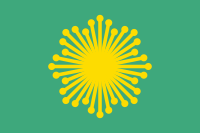
|
March 28, 1924 | The national flag of Guai depicts a golden hāni flower on a green field, standing for the hāni's foliage. Its use was already widespread when the 1791 Constitution made vaguereference to it as the national banner. During the 19th century ordinances, mainly regarding military ensigns, made the design and the tinctures more precise. By the time the National Council ordered the Council of State to specify the national flag and its uses, the hāni flower design had been stylised to a figure resembling depictions of the Eight Virtues. The flag has a 2:3 ratio or 18:27, the hāni flower being inscribed in a 14:14 square. |
| Seal of Guai | 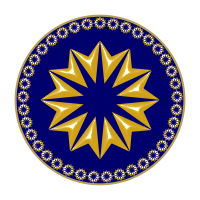
|
March 28, 1924 | The Seal of Guai displays a golden rendition of the Eight Virtues against a Taukan blue shield, a shade of deep blue traditional among the Taukan folk culture. The traditional seal is surrounded by a wreath of the same pattern, the shield being edged with gold. The current specifications were made official in 1924. The seal appears on official documents issued by the Guaiian Government or Administration, such as laws, patents, national identity card or passports. In most situations involving ink-stamping, the seal is depicted without the shield with gold replaced by ink colour. |
| National anthem | 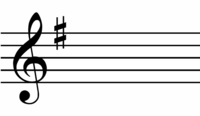 Ios Guai |
March 28, 1924 | The poem Ios Guai - Guaiian for To Thee, Guai - was composed in 1867 by writer Iustas Kūpàr (1808-1882). Native from Vai, Kūpàr (corruption of the Ingerish surname Cooper) had been mainly known for his novels when Ios Guai was published in his third volume of poetry. Neither the book nor the poem itself drew attention until 1873, when Djan Pils (1833-1902), Kūpàr's Minister at St George's Anglican Cathedral, set the poem in music. Pils composed an organ piece in G major in the form of an Ingerish church hymn. The first rendition on Sunday 24th August 1873 (the next Monday being Hāni Flower Day, a public holiday) proved immensely popular and the work was regularly played and sung by the congregation the following Sundays. Within months, the hymn was orchestrated for symphonic orchestra and military band. Though a ministerial ordinance of 1880 mandated its performance when certain officials were in attendance, only the law on national symbols of 1924 acknowledged the use of Ios Guai as national anthem and specified its uses. |
| National colours | Guaiian Green - #3ea87c Golden yellow - #fddc01
|
December 31, 1924 | The Council of State passed a decree, in application of the Law on National Symbols (March 28, 1924), specifying the shades of the national flag. This decree has been modified in 1988 and 2001 (for Internet colours) to adapt modern dyes. |
| National tree & flower |  Hāni |
17th century | The hāni flower has some religious significance in Ohoism and its fragrance has been used in some rituals. Its civic use grew during the early Old Republic and had been firmly established as a State symbol by the time the 1791 mentioned the national banner as being "green with a golden hāni". Though now devoid of religious meaning, hāni blossoming, in late winter or early spring, is still a popular event followed by the public and media. Hāni Flower Day is a national holiday observed the last Monday of August. |
| National fruit |  Maki |
1992 | Maki is a popular berry native to the central West Coast of Antarephia. In Guai, it grows particularly well south of the Kaila Noe mountain range. It's semi-official status as national fruit is due to a vote on a TV show, on the public channel, in the early 1990s. Decades later, mentioning its national fruit status is sometimes done ironically. |
| National animal |  Antarephian swan |
17th century | The Antarephian swan (Guaiian: kidjo) has been admired for its natural grace and its fierceness to defend its kind, and has been present in numerous tales and fables. Its civic use may date back to the 250-day War, during which battle cries, yelled by the Unified Army's soldiers, often contained a reference to the swan's fierceness. Though necessarily the case, the swan has often been associated with the military. For example, during the Sabishiian War (1831-1833), Guai instituted a military decoration, the Star of the Swan (Guaiian:Cam tè Kidjo). |
Public holidays
Guai legislation recognises 10 public holidays:
| Month | Date | Holiday | English |
|---|---|---|---|
| January | January 1st | (Sa tè) Saute Bi | New Year's Day |
| February | Closest Friday to the Feb. 12th | Sa tè Peia | Constitution Day |
| April | First Thursday of April | (Sa tè) Zeker tā Moké | Remembrance of the dead |
| April | First Friday of April after the first Thursday | (Sa) Tā koru | First Rains Day |
| May | May 1st | Sa tè Lyg | Labour Day |
| June | June 26th | Sa Binda Pirindi | Treaty of Pirindi Day |
| August | Last Monday of August | Sa tè Hāni | Hāni flower day |
| September | Around September 20 | (Sa tè) Nap Fanya | Vernal Equinox Day |
| October | First Monday of October | Sa tā Umi | Children's Day |
| December | First Monday of December | Sa tè Cis | Summer Day |
Arts
Science
Cuisine
Guaiian cuisine is described as a blending of traditional Antarephian cuisine with Ulethan influences, mainly Castellanese, combining local and Mediterranean ingredients acclimatised to the region. Though most dishes are now found anywhere in the country, regional cuisine displays some variations due to distinctive lands such as beef and dairy being more used south of the Kaila Noe mountains while chicken is more commonly serves elsewhere.
Ingredients
- Common ingredients
Dishes & drinks
- Dishes & drinks of Guai
Religion
Until at least the first half of the 20th century, dominant belief in Guai was called Ohoism, an amalgamation of religio-philosophical traditions that has a significant impact on shaping Guaiian culture. Since then it has steadily declined and today Guai has one of the least religious populations in the world.
People from Guai
Those are mentioned in articles or named on the map. For pronunciation, please refer to the article on Guaiian
| Family Name | First Name | Gender | Birth | Death | Profession | Known for |
|---|---|---|---|---|---|---|
| Abún | Hal | m. | 1890 | 1962 | Counsellor of State | Responsible for founding KoPaSA, the national railway company |
| Apār | Fiordja | f. | 1959 | Pharmacist | Married to Izabela Enler-Riter, President of Ullanne | |
| Ármel | Kleia | f. | 1972 | CEO | CEO of TÁNGOKÏO | |
| Balan | Ingo | m. | 1876 | 1954 | Counsellor of State | Initiator of various public services (eg: postal services) |
| Bin | Djos | m. | 1964 | CEO | CEO of FlyMe | |
| Bing | Lwfinda | f. | 1886 | 1970 | Biologist | Animal specialist |
| Djon | Wlinta | f. | 1857 | 1930 | Doctor | Microbiologist specialised in vaccines |
| Eleban | Soroi | m. | 1887 | 1959 | Architect | Built the Geolympic Stadium |
| Elva | Erym | f. | 1882 | 1973 | Stage actress | |
| Erym | Arno | m. | 1910 | 1982 | sportsman | Football player |
| Fenok | Adrián | m. | 1840 | 1902 | Writer | Novelist |
| Git | Iohán | m. | 1798 | 1840 | Writer | Poet of the Romantic period |
| Hāni | Elyg | m. | 1789 | 1863 | Painter | Romantic painter |
| Iafri | Yrme | m. | 1831 | 1904 | Judge | President of the High Court of Justice |
| Ions | Hag | m. | 1898 | 1964 | Aviator | |
| Káparw | Cumi | m. | 1920 | 2012 | sportsman | Boxer, geolympic medalist |
| Kerosi | Áili | m. | 1825 | 1912 | Philantropist | Builder of hospitals and orphanages |
| Kilin | Launa | f. | 1866 | 1932 | Painter | Her many symbolist paintings |
| Klaj | Emen | m. | Mid-18th century | Early 19th century | Trip hammer maker | Founder of Aspra Industries |
| Klaj | Soroi | m. | Mid-18th century | Early 19th century | Trip hammer maker | Founder of Aspra Industries |
| Kohen | Izák | m. | 1845 | 1934 | Counsellor of State | |
| Kohen | Iusi | m. | 1792 | 1868 | Philantropist | |
| Kūpàr | Iustas | m. | 1808 | 1882 | Writer | Author of the national anthem Ios Guai in 1867 |
| Mikin | Soroi | m. | 1958 | CEO | CEO of Guai Airways | |
| Nasdel | Famí | f. | 1902 | 1984 | sportsman | Tennis player, Antarephian Games medalist |
| Nìaj | Mikino | m. | 1910 | 1988 | Sportsman | Swimmer, Antarephian Games medalist |
| Orlut | Pinga | f. | 1842 | 1920 | Doctor | First female paediatrician in Guai |
| Ótwlangar | Meeri | m. | 1802 | 1878 | Counsellor of State | Father of the Constitution |
| Palvid | Hag | m. | 1886 | 1974 | Philantropist | Son of Djorj Palvid. Art collector |
| Palvid | Djorj | m. | 1852 | 1921 | Counsellor of State | Father of Hag Palvid |
| Paranala | Emón | m. | 1854 | 1932 | Counsellor of State | Responsible for building the National Healthcare system |
| Pei | Laran | m. | 1885 | 1958 | scuptor | |
| Pemel | Fiordja | f. | 1968 | Counsellor of State | Head of the Department of Foreign Affairs | |
| Pils | Onori | m. | 1887 | 1965 | Military Officer | General (unrelated to Djan Pils) |
| Pils | Djan | m. | 1833 | 1902 | Anglican Minister & Composer | Composer of the national anthem Ios Guai in 1873 |
| Polisoz | Fran | m. | 1777 | 1846 | Professor | First dean of the University of Vai |
| Safoi | Cilia | f. | 1876 | 1952 | Consellor of State | First female counsellor of state |
| Sondari | Elva | f. | 1887 | 1963 | Astronomer | Headed the National Astronomical Society |
| Swran | Ebir | m. | 1875 | 1947 | Shopkeeper | Founder of Swran bookshops |
| Taiarón | Emil | m. | 1802 | 1885 | Counsellor of State | Lauched the codification process of Guaiian Law |
| Taka | Patin | m. | 1829 | 1903 | Military Officer | Admiral of the Fleet |
| Tora | Oaro | m. | 1827 | 1886 | Military Officer | General |
| Twsenw | Irán | m. | 1831 | 1916 | Municipal Counsellor | Responsible for launching a planned urban expansion for Vai |
| Uarai | Orón | m. | 1798 | 1852 | Composer | Opera & operetta composer |
| Wlof | Namin | m. | 1796 | 1852 | Writer | |
| Ȳrlis | Arko | m. | 1715 | 1792 | Diplomat | Headed the first embassy to Mauretia |
| Zabāni | Erói | m. | 1816 | 1906 | Composer | Considered the national composer of Guai |




